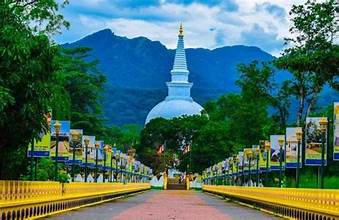…Mahiyangana Temple…
Mahiyangana Raja Maha Vihara: A Sacred Buddhist Temple in Sri Lanka
Introduction
Located in the eastern part of Sri Lanka, the Mahiyangana Raja Maha Vihara is one of the island’s most significant and ancient Buddhist temples. It is revered not only for its historical and architectural value but also for its association with the life of the Buddha. The temple holds a unique place in Sri Lanka’s religious and cultural landscape and is an important pilgrimage site for Buddhists around the world.
Historical Significance
The Mahiyangana Raja Maha Vihara is believed to be the site where the Buddha first visited Sri Lanka, around 2,500 years ago. According to Buddhist tradition, during his third visit to the island, the Buddha came to the area of Mahiyangana to deliver a sermon to the local Yakkha (demon) tribes. The event is considered one of the most significant moments in Sri Lanka’s Buddhist history, as it marked the introduction of Buddhism to the island.
It is also believed that during his visit, the Buddha established a stupa (a Buddhist monument that houses relics) at Mahiyangana, making it a sacred site for Buddhists. Over time, the stupa was renovated and expanded, and a larger temple complex was built around it, which now houses several other structures of religious and cultural importance.
Architectural Features
The Mahiyangana Raja Maha Vihara is known for its beautiful and peaceful setting, nestled within the lush green forests of the Uva Province. The temple complex is built in the traditional Sri Lankan Buddhist style, with a large central stupa surrounded by various smaller shrines, monastic buildings, and meditation areas. The architecture of the temple combines elements of ancient and modern Sri Lankan Buddhist styles.
The main stupa, which is the focal point of the temple, stands tall and serene, symbolizing the Buddha’s presence. The stupa is surrounded by intricate carvings, stone pillars, and statues of the Buddha, which are admired by pilgrims and visitors for their craftsmanship. The surrounding area is peaceful and tranquil, providing an ideal environment for meditation and reflection.
Cultural and Religious Importance
Mahiyangana Raja Maha Vihara plays a central role in the spiritual life of the local community as well as in the broader Buddhist traditions of Sri Lanka. The temple hosts various religious festivals, the most important being the Vesak festival, which celebrates the birth, enlightenment, and death of the Buddha. During this time, thousands of pilgrims visit the temple to pay homage to the Buddha and participate in ceremonies.
The temple also serves as a center for Buddhist learning and meditation. Monks from the temple engage in spiritual practices, while also providing teachings and guidance to lay followers. The serene surroundings and the presence of the ancient stupa make it an ideal place for meditation, attracting both local devotees and foreign visitors seeking spiritual solace.
Legends and Myths
The Mahiyangana Raja Maha Vihara is steeped in legends that have been passed down through generations. One of the most well-known myths surrounding the site involves the Buddha’s interaction with the Yakkha tribe. According to legend, the Yakkha chieftain, a powerful figure in the region, was initially hostile toward the Buddha’s teachings. However, after hearing the Buddha’s sermon, he was converted and subsequently became a devout follower.
Another popular story is that the Buddha, during his visit, left behind a relic, which was enshrined within the stupa at Mahiyangana. This relic is believed to be one of the earliest in Sri Lanka, and it continues to add to the sacredness of the temple, making it one of the most revered Buddhist sites on the island.
Tourism and Pilgrimage
While Mahiyangana is not as well-known internationally as some of Sri Lanka’s other temples, it is an essential pilgrimage site for Buddhists in Sri Lanka. The peaceful surroundings and the historical significance of the site make it a must-visit for those seeking to experience the spiritual heart of the island.
The temple is open to visitors throughout the year, and many come to meditate, participate in religious ceremonies, or simply explore the rich cultural heritage of the area. The town of Mahiyangana, which is situated nearby, provides accommodations and amenities for those making the journey.
Conclusion
Mahiyangana Raja Maha Vihara is not just an important Buddhist temple, but also a symbol of Sri Lanka’s deep-rooted Buddhist heritage. Its historical significance, architectural beauty, and serene environment make it a sacred site of great spiritual importance. For those seeking to connect with the ancient traditions of Buddhism, Mahiyangana is a place that offers peace, reflection, and a deeper understanding of the island’s cultural and religious identity. Whether you are a pilgrim or a traveler, a visit to Mahiyangana Raja Maha Vihara is an experience that will leave you with lasting impressions of Sri Lanka’s rich spiritual history.

